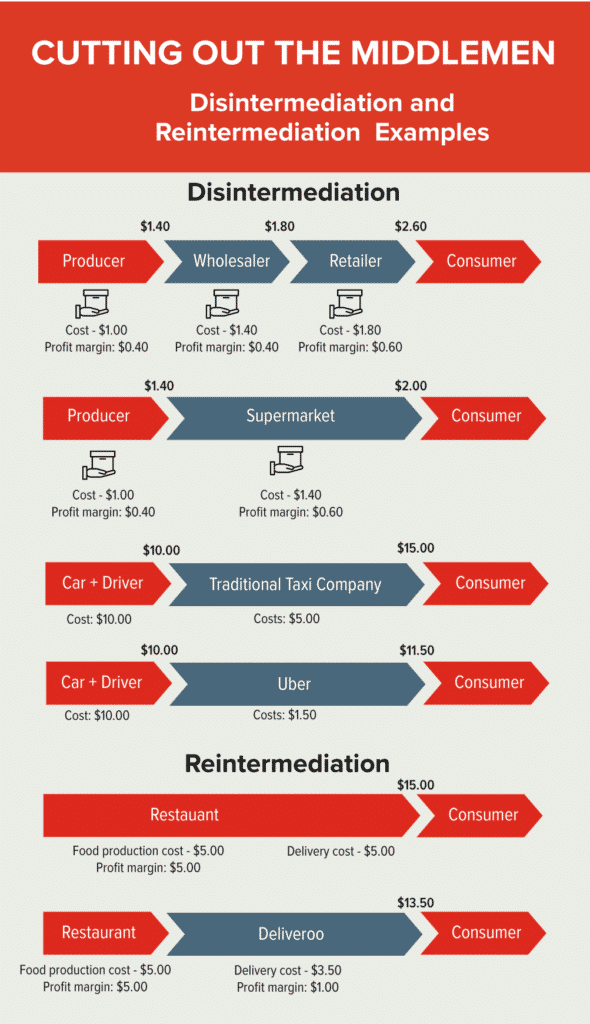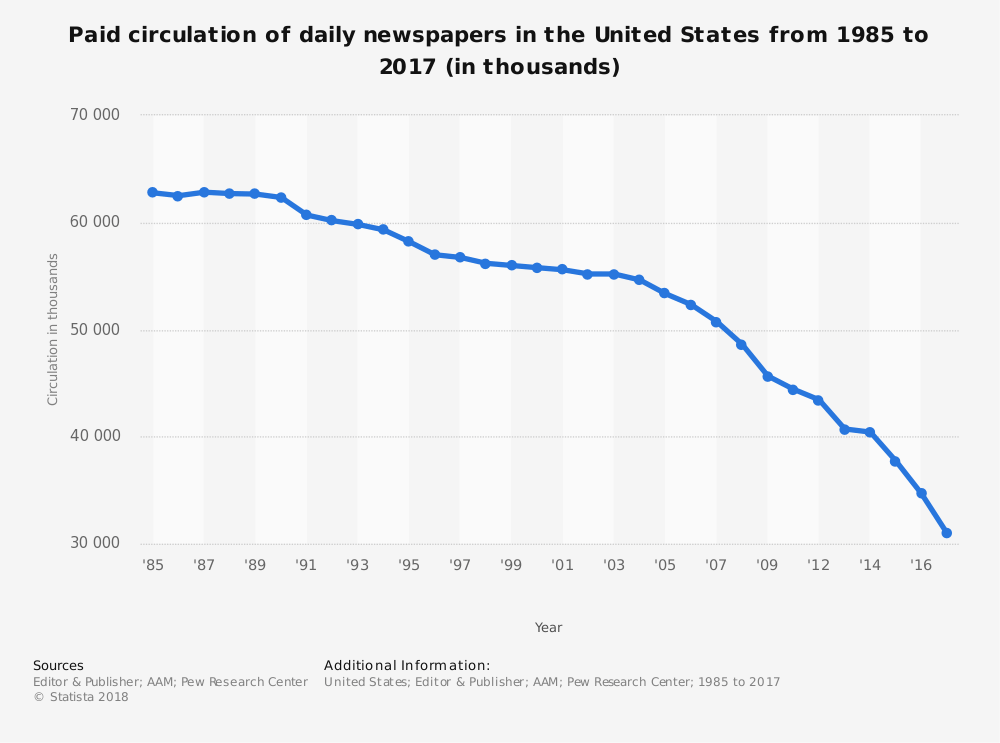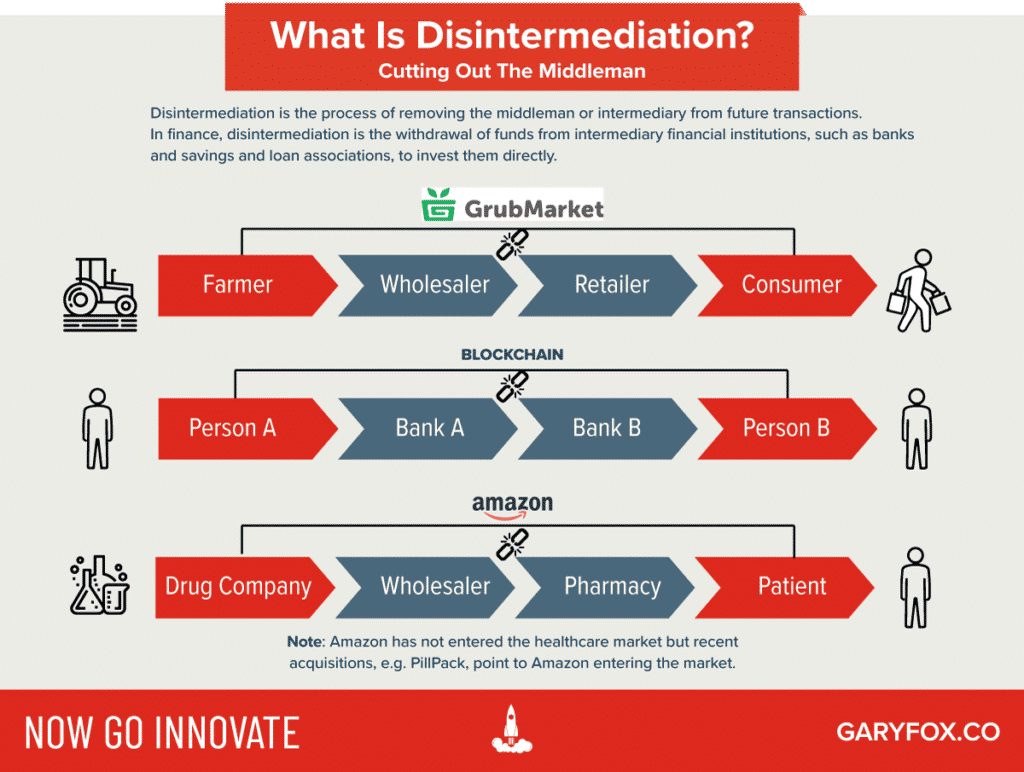Disintermediation is talked about in most cases as a form of disruption, however, you need to understand how value is created to get the heart of it.
A typical example is how farmers can sell direct to consumers through platforms rather than distribute their products through wholesalers and retailers. Another term frequently associated with disintermediation is direct to consumer business model.
Amazon founder, Jeff Bezos, who is known for historically eliminating the middleman to benefit the customer said, “Even well-meaning gatekeepers slow innovation.” If we want to continue to innovate at an accelerated rate, the gatekeepers must go.
Disintermediation Disrupts Markets
Disintermediation displaces the middlemen with the value chain and as a result, changes the dynamics with the market. These changes are classically driven changes in technology that enable value chains to be reconfigured.
The internet and the rise of digital platforms that can connect two-sides of a market have caused the displacement of many traditional intermediaries.
Benefits of Disintermediation
The opportunity is to deliver a product or service to a consumer with higher perceived value than an incumbent’s by changing the fundamental way it is delivered.
Each part of the supply involves time and money. Each intermediary will take add a margin to the product or service and hence the final cost to the consumer can have several layers of profits and costs associated with the value chain e.g. distribution, storage and transportation costs.
Cutting out the middlemen reduces the number of costs and often time to get to the consumer.
Disintermediation Examples

The digitization of products has led to transforming physical products into zeros and ones, digits. Books, music and even money are now digitized and therefore easy to distribute.
Digital goods can be delivered over the internet either as a bundle or as a single unit (referred to as unbundling). Music tracks, video, software, newspapers, books are now easily distributed through multiple channels and viewable on a range of devices.
Disintermediation of the Newsagents and the Print industry
As the news became available online, the print and distribution of newspapers plummeted along with the number of newspaper companies. Many newsagents groups (shops selling newspapers and magazines) went out of business as a result of being disintermediated.

Disintermediation of Travel Agencies
Travel agents used to be a familiar sight on every high street. However, the internet transformed the industry and the layers of intermediaries fell the wayside. Expedia and bookings.com made it easy for hotels to directly list their rooms on these sites and cut out the travel agents all together.
Disintermediation of Taxi Companies
Uber has grown rapidly from launch to now being a regular option for people seeking rides in over 60 Countries. The traditional taxi company and it’s associated costs of cars, an office and staff to man the phones have been replaced by the Uber app. A person seeking a ride can now find a driver easily within their vicinity. Consequently, the Uber business model results in only a fraction of markup to cover its costs and make a profit, therefore causing disintermediation in the taxi industry.
Disintermediation of Pet Stores and Wholesalers
Direct to consumer startup BarkBox identified the opportunity to serve just one demographic, die-hard dog lovers directly, with just one core product: its eponymous BarkBox. However, by doing so it cuts out the normal wholesaler and pet supply store.
Fintech and Disintermediation of Banks
Fintech through Big Data, Blockchain, Internet of Things (IoT), use of Cryptocurrencies, Artificial Intelligence (AI) and more effective exploitation of digital channels, social networking and mobile devices is disintermediating the financial services industry through innovation.
Robo Advisory is a term used to describe the automation of financial services traditionally provided by human financial advisors, which now can be done via code, and through an automated process.
Disintermediation vs Reintermediation
Disintermediation is enabled through digital platforms that connect two sides of a market and cut out the middlemen. As a result, the margins normally absorbed by the middlemen can lead to improved profits for the producer and often lower costs for consumers.
Reintermediation is the opposite of disintermediation. Reintermdiation involves the introduction of an intermediary, a middleman, between a supplier and a customer.
Quite often this happens because a company will outsource a service so that it can focus on its core activities, e.g. what it does best. Another reason for reintermediation is convenience and the ability to focus on one particular part of the value chain.
Reintermediation Examples
Levi Strauss & Co. didn’t score any points when it decided to shut out retailers from selling its blue jeans and other clothing online.
Initially, Levi Strauss thought it wanted to keep the eCommerce to itself. However, less than one year later and with declining sales, the $6 billion manufacturer, abruptly changed course.
Levi’s announced that it would quit direct sales on the Web and leave online selling of its clothing to retailers like J. C. Penney Co. and Macys.com. However, later it reintroduced its online store but maintained distribution with its retail partners.
A great example of reintermediation is Deliveroo, a company founded in 2013. Deliveroo is an online food delivery company that partners with restaurants across cities to manage the whole takeaway process from restaurant pickup to customer delivery, again through a mobile app.
Deliveroo has allowed more restaurants to offer a delivery service where the traditional internal cost of doing so proved a barrier. Also, it provided an outsourced more efficient delivery option for restaurants offering their own service.
Without Deliveroo, a delivery would require the investment costs of a vehicle(s), employment of driver(s) and logistics planning.



